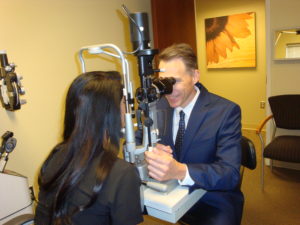What is Glaucoma?
 Glaucoma is one of the leading causes of preventable blindness in the world. It is an eye disease of the optic nerve. This nerve carries visual information from the eye to the brain. The disease affects peripheral vision first.
Glaucoma is one of the leading causes of preventable blindness in the world. It is an eye disease of the optic nerve. This nerve carries visual information from the eye to the brain. The disease affects peripheral vision first.
What are risk factors for glaucoma?
The loss of vision occurs over a long period of time. There are usually no symptoms of the disease until the damage is advanced. Once the visual field is damaged, the lost function cannot be recovered. Important risk factors include: age, family history, evaluated eye pressure, thin corneas, African American or Hispanic ancestry, past eye trauma, and diabetes.
Patients with risk factors are considered glaucoma suspects. Early diagnosis can prevent vision loss from this devastating disease.
Diagnosis
All of our ophthalmologists specialize in the early detection of this blinding disease.
This takes place with a complete, dilated ophthalmologic exam. If our doctors find a suspicious finding or there is a known risk factor, additional diagnostic testing may be performed in our office.
Intraocular pressures are measured with anesthetic drops and Goldman tonometry and applanation. There is no puff of air. Raised intraocular pressure is a significant risk factor for developing the disease. However, patients can develop nerve damage even with normal intraocular pressures (normal tension).
Some patients develop glaucoma at relatively low pressures while others have high eye pressures and never develop damage to their optic nerve.
Diagnostic Test for Glaucoma
Corneal pachymetry measures central corneal thickness. Thin corneas are a risk factor for glaucoma. Thick corneas are protective. Corneal pachymetry helps our doctors decide a patient’s true intraocular pressure.
Dilated fundus examinations allow the ophthalmologist to examine the optic nerve stereoscopically and look for any early changes suggestive of nerve damage. Dilation also allows for a thorough view of the retina searching for other ophthalmologic and systemic diseases.
Formal peripheral Humphrey Visual field testing can detect early changes and serve as a baseline for future reference. This test takes place in our office and requires time, attention and expertise interpretation.
Optical Coherence Tomography allows for a quick scanning of the retinal nerve fiber layer surrounding the optic nerve and also serves as a baseline and excellent screening tool. This additional test is used if the doctor is concerned about the health of a patient’s optic nerve.
Types of Glaucoma
Glaucoma is divided into two major categories: open angle and narrow angle. A detailed, comprehensive examination by an ophthalmologist is imperative in correctly diagnosing the disease. Open angle glaucoma (Chronic Open Angle Glaucoma, or, COAG) has many subcategories. The type of glaucoma, risk factors, health of the optic nerve, and visual field help doctors determine what the best course of treatment is for each individual patient.
Treatment
Narrow angle glaucoma may require a prophylactic laser procedure (iridotomy) to prevent serious complications such as closed angle glaucoma. Treatment for glaucoma may include close observation alone, eye drops, laser surgery or filtering surgery. Our doctors specialize in both the medical and surgical treatment of glaucoma. Newer drops can prevent vision loss in most cases. Some patients may require advance surgery involving a tube or shunt drainage device.